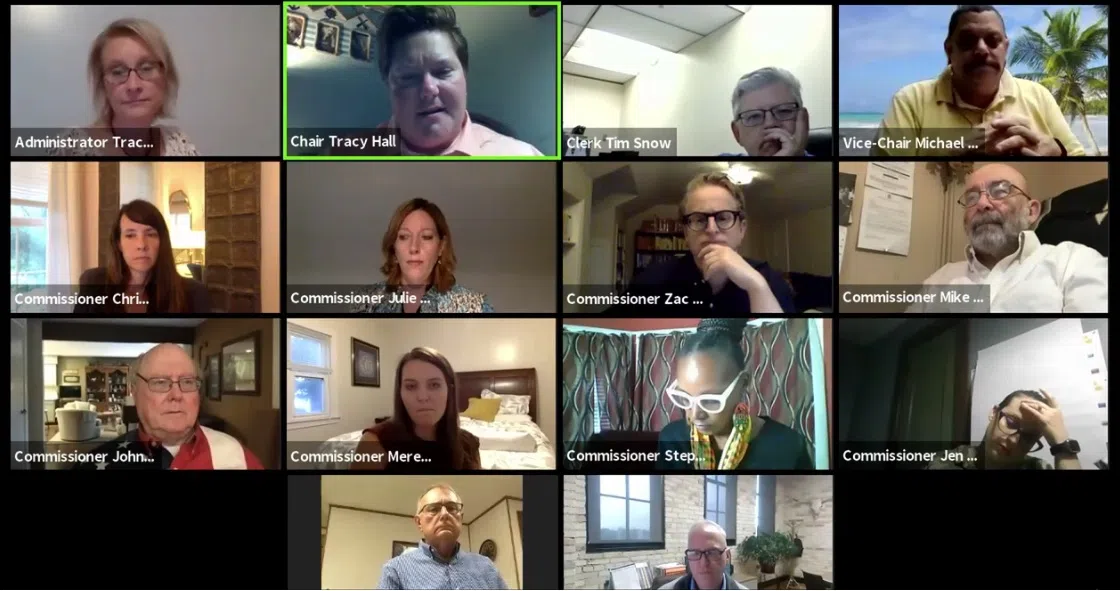KALAMAZOO COUNTY, MI (WKZO AM/FM) — Kalamazoo County health officials are providing an update to COVID-19 as it relates to schools starting up again.
During a virtual meeting Tuesday, county health officer James Rutherford gave a presentation to the Kalamazoo County Board of Commissioners.
During the presentation, Rutherford outlined several facets of the situation, including a rundown of the different types of education plans and what local universities are planning to do.
Data on students and COVID-19 cases –
“When we talk to our schools, particularly our K-12 and colleges, we really want to help articulate an understanding of demographics as it relates to both their employees, but also their students,” Rutherford said.
According to data presented, the majority of cases occur with individuals over the age of 40. Rutherford said that in Kalamazoo County, 12.3 percent of cases have occurred in ages 19 years and under, and ten percent when ignoring the outbreak at Lakeside Academy.
“It’s important to be able to understand why we could potentially look at Lakeside as an anomaly, because they really didn’t impart any of the public health recommendations for that particular setting,” Rutherford said.
He added that there have been no COVID-related deaths in residents under the age of 19 through the county, and that those under 19 that were hospitalized make up 3.6 percent of the total hospitalizations.
Return to School Guide –
Rutherford also discussed the reopening of schools as they relate to Governor Whitmer’s Executive Orders. He said the MI Safe School guide released by the county is the road map of what the Kalamazoo County guidance is based on.
“It’s important to remember that the schools’ re-engagement is clearly and totally up to them in terms of whether or not they go with a full on-site face-to-face learning, or if they go with remote learning,” Rutherford said.
Kalamazoo Public Schools are allowing a choice between a fully online fall trimester to phase back into in-person learning, while Portage Public Schools are allowing hybrid learning from the start.
Rutherford said the plan can be fully reviewed by the public at the county website.
Regional Differences –
When it comes to the danger levels of the COVID-19 spread, the State of Michigan is divided into eight different regions, each color-coded and numbered to mark a different phase.
Currently, the Kalamazoo region is in Phase 4, which means “Improving,” according to the State of Michigan Coronavirus website. Phase 1 is the worst, while Phase 6 means “post-pandemic.” Each phase has an effect on how schools will reopen.
“We are currently in Phase 4, which is identified by the virus status being that the number of new cases within our region has fallen, but overall, we still have some activity in the State of Michigan,” Rutherford said. “This phase does allow the schools to have in-person instruction. If we go backwards, all the schools have to go back to remote learning.”
He identified areas in the Upper Peninsula that are in Phase 5, which turns requirements to recommendations.
Risk in School Settings –
“When we talk about re-engaging our schools, we really need to be mindful of the risks that we get questions about,” Rutherford said. “The data is significantly supporting the fact that people over the age of 60 are more vulnerable to COVID, particularly the complications from COVID than other people.”
He also said those with preexisting conditions are more likely to have complications from COVID-19. Rutherford said discussions have been had with area schools about their demographics and populations.
“It’s important for them to look within their staffing to say, do we have people over the age of 60, do we have people with chronic medical conditions, and what can we to best protect their vulnerability?” Rutherford said. “The data leans very heavily towards the reality that the 0-20 age group has been impacted much less severely than other age groups.”
However, Rutherford says there are still risks for that age group.
“Within this population, there are groups of kids that have some of those chronic medical conditions,” Rutherford said. “Also, we have individuals, particularly within that 0-20 population, that might be recovering from something like chemotherapy because of cancer treatment, and they have a very vulnerable and compromised immunity. When we talk about the risk in school settings, it’s important to look at these vulnerable populations.”
Mitigation Strategies –
Rutherford said that a handful of strategies are going to be crucial to reopening schools.
“When we talk about these public health recommendations, they’re pretty simple, and a lot of these have been around for centuries when we talk about good public health practices,” Rutherford said.
That starts with people staying home if they’re sick, and Rutherford says that includes students and staff alike. However, Rutherford says this will be further complicated by the upcoming flu season.
“Many of the symptoms that we see in COVID-19 are the same symptoms that we see in seasonal influenza and the common cold, which is also in the Coronavirus family,” Rutherford said. “It adds another level of complexity, but its part of what we need to be diligent about. People need to stay home when they’re sick.”
Rutherford also reminded the board that frequent hand-washing and wearing a face mask is critical to avoid getting sick.
“Face masks have become a big part of everything we do on a daily basis,” Rutherford said. “That’s gonna be prevalent within the schools, as well.”
Personal Protective Equipment (PPE) availability and social distancing are also factors, Rutherford said.
“Physical distancing, we know that’s a challenge with some of our schools, but the gold standard is to get that six feet of separation, making sure we really take advantage of trying to reduce that density,” Rutherford said. “Some of the schools that are going to hybrid models with smaller groups coming in, that should help compliment that distancing.”
Frequent cleaning and sanitation of school facilities and keeping soap and sanitizer is a part of that, as well as encouraging students with signage. Frequent health screenings are also recommended.
What if a Student Gets Sick? –

Kalamazoo County Health Officer James Rutherford presents a flowchart on the procedure for a student who tests positive for COVID-19. (Photo via PMN Civic Livestream).
“The million dollar question is what happens when we get a student that is positive for COVID-19,” Rutherford said.
He presented a flowchart explaining the process, which involves creating an isolation area and contact tracing procedure.
“The student should be sent home as soon as possible,” Rutherford said. “We want as little activity as possible, we don’t want any interaction with any other students or staff. That’s when we’ll be contacted by the school, that student should go to their primary caregiver.”
He said that the student caregiver should determine whether or not a test will take place, and if so, they should be tested as soon as possible.
“In the event testing takes place, we want to make sure it’s rapid and that we can get a response pretty quickly,” Rutherford said. “Once the tests comes back, that’s the impetus for our involvement. If it’s positive, that’s when we start our process of doing contact tracing, working with the school, doing our disease investigation, determining the isolation that’s necessary, and any subsequent quarantining that will be necessary as well. We’ll determine when those students are able to come back into the system safely.”
He said that the same process is true for any staff members who test positive.
University Decisions –
“The difference between K-12 and the colleges is that there really wasn’t a development of a road map from the Governor’s office for the colleges,” Rutherford said. “We’ve taken some of what we can from the K-12 road map, but we’ve kind of been on our own a little bit in terms of planning with them.”
Rutherford gave a basic breakdown of what each college in the area is planning to do. Western Michigan University (WMU) has opted for hybrid learning and on-campus living, while Kalamazoo College has opted to go fully online. Kalamazoo Valley Community College is also providing hybrid learning options.
Kalamazoo College opted to go fully online after a student petition from the college newspaper, The Index, released an editorial and a petition calling on the university to do so. A similar letter was released by the WMU newspaper, the Western Herald, and a student protest was held Monday on campus.
WMU has vowed to report any cases of COVID-19 in students. By last Friday, 16 new cases had been recorded, making a total of 69 positive cases since March.
Monday, MLive reported that a student protest was taking place on WMU’s campus, which was meant to call for a fully-online semester by Friday, September 4 at 5 p.m. The Vice President of Academic Affairs, Jennifer Bott, met with the group to listen to their demands.
Earlier on Tuesday, MLive reported that there are no plans of a university shutdown should cases increase, according to Vice President of Student Affairs Diane Anderson.
WMU is scheduled to begin classes this Wednesday.
Going Forward –
“When we talk about the key to success with schools, it’s really about constant regular communication,” Rutherford said. “We have weekly meetings with all of our Superintendents and will continue that well into phase six. We meet with our colleges on a very regular basis, we still continue to meet on Tuesdays and Thursdays with both of our health systems, with our laboratory, with Western Michigan University, as well as K College as part of those conversations.”
The key, Rutherford said, is strict adherence to public health recommendations. But either way, Rutherford said new cases in schools are unavoidable.
“It’s not a matter of ‘if,’ and we know that we’ve already got positive cases at Western Michigan University,” Rutherford said. “We don’t want to pretend that this is going to be without incident, because we are going to have positive cases.”
He said that citizens need to avoid “Magical Thinking” while the pandemic continues.
“I know everyone is sick of it, we all want to be done with it, but we’re not, so we have to continue to put our head down and be diligent, and make sure we do our work, make sure people understand that we’re going to have continued activity, but that we’re addressing that.”
He also said that, keeping in mind with the fact that WMU is in a college town, local law enforcement agencies, bars and restaurants have been informed and prepared for the campus return.
“We know that these super-spreader incidents are a possibility,” Rutherford said. “We know that we have kids coming into a university environment, many of them have one thing on their mind – many of them are going to get frustrated because there’s not the typical amount of classes, so they’re going to get bored. We have to be diligent about that.”
Rutherford says that going forward, all residents should continue adhering to public health recommendations, including social distancing, good hygiene and wearing a mask.
Furthermore, residents should get a flu shot as soon as possible to avoid further complications.
“Getting our flu shots this year is more important than any other year we’ve been alive,” Rutherford said. “Trying to prevent other illnesses is a significant mitigation strategy.”
Rutherford recommends residents review the Kalamazoo County COVID-19 website for more details and resources. The educational plan can be viewed here.
Statewide data from Michigan can be viewed here.









Comments